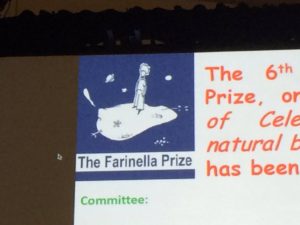Fourth day of the DPS meeting, and I found myself sitting through some great plenary talks.
 First up was Kleomenis Tsiganis‘s Farinella Prize lecture “Flavors of Chaos”, a rapid-fire tour of the intricate and complex web of gravitational interactions among planets and asteroids in our solar system.
First up was Kleomenis Tsiganis‘s Farinella Prize lecture “Flavors of Chaos”, a rapid-fire tour of the intricate and complex web of gravitational interactions among planets and asteroids in our solar system.
Tsiganis’s described how, using a combination of computational and pencil-and-paper techniques, we can pick at the threads in this cosmic network to tease out the early history and evolution of our solar system.
For instance, the orbits of asteroids in the asteroid belt provide subtle clues that, billions of years ago, Jupiter moved inward almost to the orbit of Mars before backing out near to its current orbit, a celestial maneuver referred to as “The Grand Tack“.
 This presentation was followed by Leigh Fletcher‘s Urey Prize talk about the menagerie of seasonal changes we observe in the atmospheres for all the outer planets, from Jupiter to Neptune.
This presentation was followed by Leigh Fletcher‘s Urey Prize talk about the menagerie of seasonal changes we observe in the atmospheres for all the outer planets, from Jupiter to Neptune.
The talk was full of beautiful images of the roiling and boiling of planetary atmospheres and concluded with Fletcher’s plea to send another mission to the Uranus or Neptune before he’s too old to participate (some plans from NASA have a mission launching to Uranus or Neptune sometime in the late 2020s/mid-2030s).
Finally, we had a tag-team talk from Ashwin Vasaveda and Sanjeev Gupta about new results from Mars Curiosity rover. In addition to the stupefying images, the thing that impressed me most about the talk was just the level of detail to which we can infer the geological history of Gale Crater, where Curiosity landed.
 Gupta described how the tilt of beds of sedimentary rock could be used to infer the presence of a river delta spilling out into the crater, which suggests the existence of a long-lived (millions of years) lake in the crater, probably billions of years ago when Mars was warmer and wetter.
Gupta described how the tilt of beds of sedimentary rock could be used to infer the presence of a river delta spilling out into the crater, which suggests the existence of a long-lived (millions of years) lake in the crater, probably billions of years ago when Mars was warmer and wetter.
